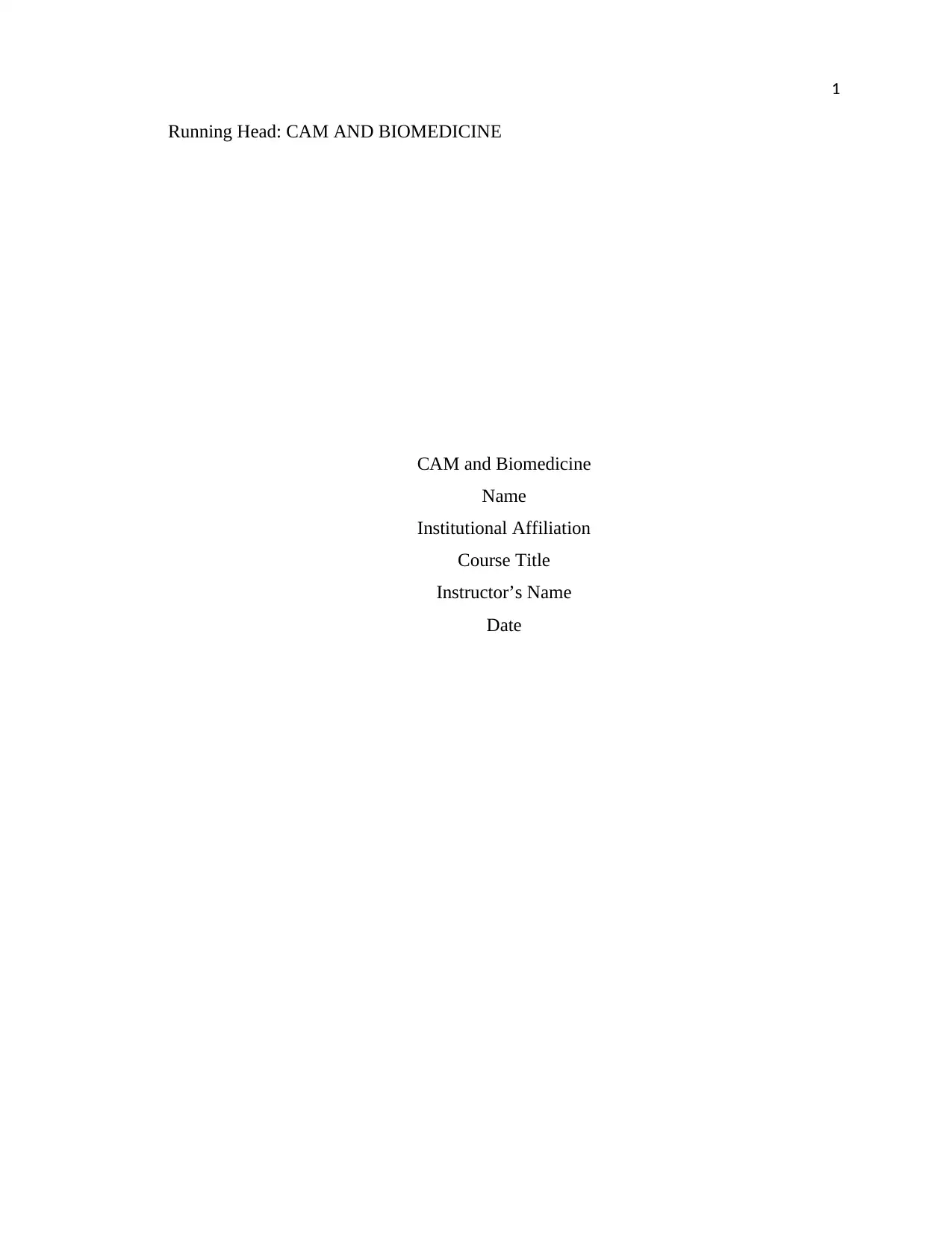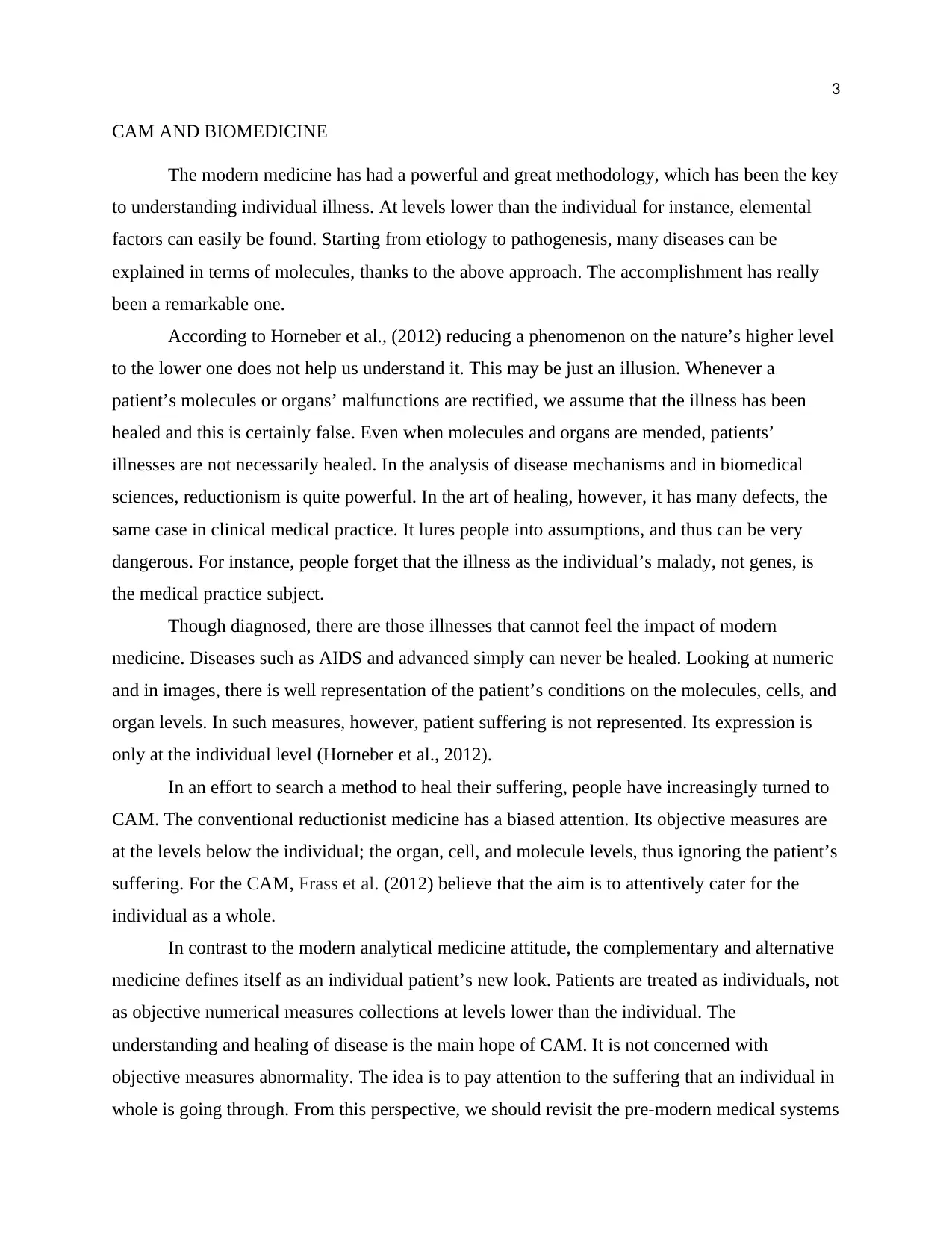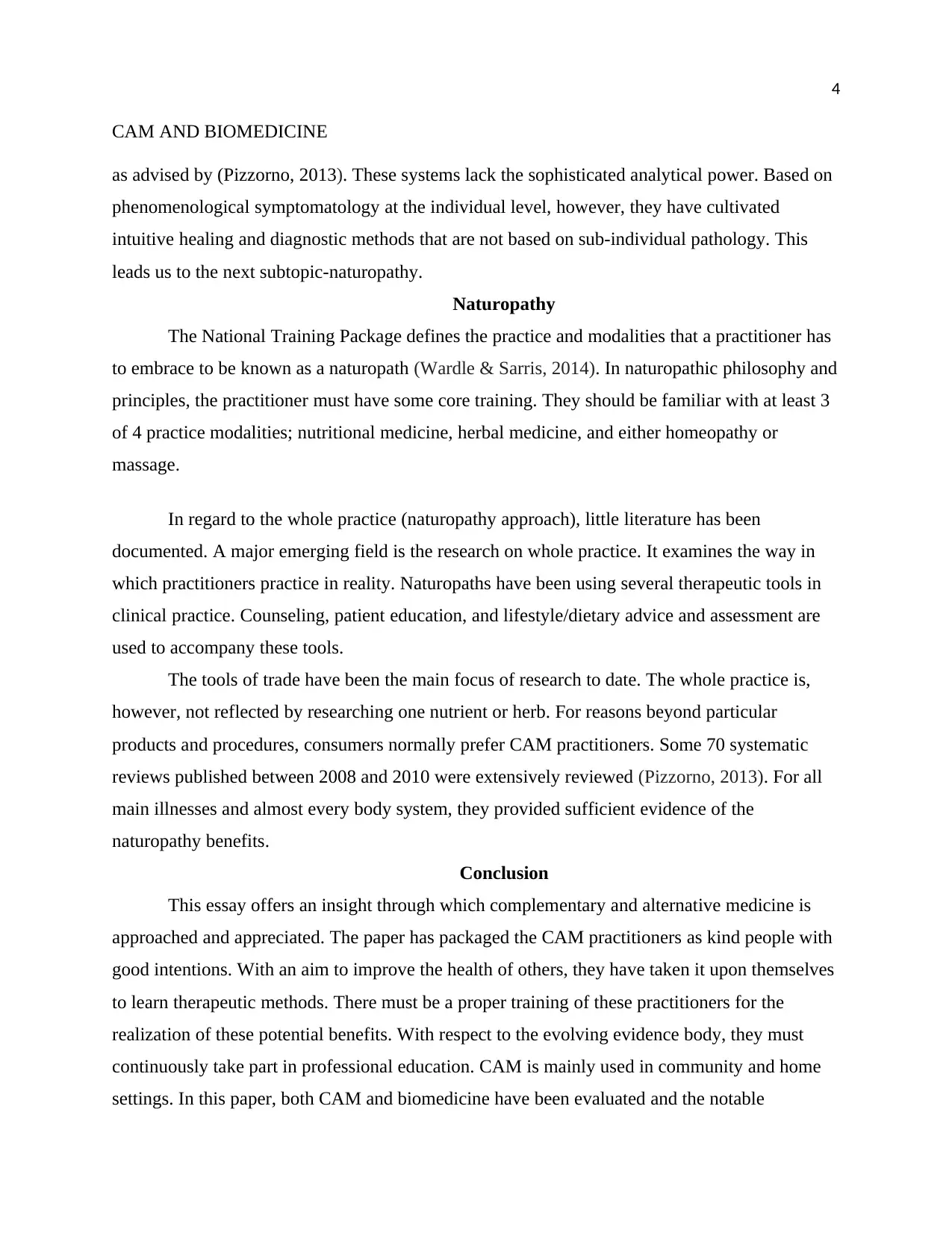CAM and Biomedicine: Exploring Philosophies and Practices
VerifiedAdded on 2021/10/08
|6
|1650
|58
Essay
AI Summary
This essay provides a comprehensive overview of complementary and alternative medicine (CAM) and biomedicine, highlighting their contrasting philosophies and approaches to healthcare. It defines CAM as an umbrella term for various therapeutic practices, contrasting it with biomedicine, often referred to as modern Western medicine. The essay delves into the historical understanding of disease, from pre-modern eras to the reductionist approach of modern medicine, which focuses on cellular and genetic levels. It discusses the limitations of reductionism in healing and the importance of considering the individual's experience of illness. The essay then explores naturopathy as a key CAM modality, outlining its principles and practices, including nutritional medicine, herbal medicine, and patient counseling. It concludes by emphasizing the potential benefits of CAM, the need for proper training of practitioners, and the importance of integrating CAM with biomedicine to improve patient care, particularly in settings like aged care facilities and hospitals.

1
Running Head: CAM AND BIOMEDICINE
CAM and Biomedicine
Name
Institutional Affiliation
Course Title
Instructor’s Name
Date
Running Head: CAM AND BIOMEDICINE
CAM and Biomedicine
Name
Institutional Affiliation
Course Title
Instructor’s Name
Date
Paraphrase This Document
Need a fresh take? Get an instant paraphrase of this document with our AI Paraphraser

2
CAM AND BIOMEDICINE
Introduction
The term complementary and alternative medicine is often referred to as holistic
medicine, complementary healthcare, or natural therapies. It acts as an umbrella under which
several therapeutic practices can be grouped (Adams, Andrews, Barnes, Broom & Magin,
2012) .Some individuals regard CAM as something negative. They describe it as non-western,
non-conventional, or unorthodox. It is normally treated as something secondary, even in positive
terms, which complements modern Western medicine (orthodox). The study outlines the
philosophies of both CAM and biomedicine in brief, in addition to explaining the key difference
(Adams et al., 2012).
Considering what Mehta (2012) said, a group of diverse healthcare systems and medical
therapies is what CAM is all about. The therapies are based on explanatory mechanisms and are
inconsistent with the biomedical model. Medicine is a science of the human person, as held by
CAM systems. Diseases are understood to involve the whole person’s systemic dislocation.
Nutritional medicine, Western herbal medicine, and naturopathy are the major CAM modalities,
but this study is mainly concerned with naturopathy.
Contemporary and alternative medicine vs. modern western medicine
Clarke,Black, Stussman, Barnes, & Nahin (2015) believe that laws governing the
nature’s higher hierarchy level are restricted by those of its lower levels. The rules governing
lower level describe and restrict many of the higher level’s phenomena. The history of our
disease understanding helps us to easily view this. Human disease was regarded as a spell or
misfortune in pre-modern eras. The exact human body anatomy was the basis of modern Western
medicine beginning from 18th century. The concept of illness as organs malfunction (individual
lower level) was introduced (Clarke et al., 2015).
The pathology object was later scaled down to the cells levels in the next century. As
declared by Pizzorno (2013) cellular biology was thus introduced. The path was further pursued
to molecules, and later genes. There has been an accomplishment of diseases’ modern scientific
understanding. This was facilitated through the reduction of objects from individual level all the
way to genetic level.
CAM AND BIOMEDICINE
Introduction
The term complementary and alternative medicine is often referred to as holistic
medicine, complementary healthcare, or natural therapies. It acts as an umbrella under which
several therapeutic practices can be grouped (Adams, Andrews, Barnes, Broom & Magin,
2012) .Some individuals regard CAM as something negative. They describe it as non-western,
non-conventional, or unorthodox. It is normally treated as something secondary, even in positive
terms, which complements modern Western medicine (orthodox). The study outlines the
philosophies of both CAM and biomedicine in brief, in addition to explaining the key difference
(Adams et al., 2012).
Considering what Mehta (2012) said, a group of diverse healthcare systems and medical
therapies is what CAM is all about. The therapies are based on explanatory mechanisms and are
inconsistent with the biomedical model. Medicine is a science of the human person, as held by
CAM systems. Diseases are understood to involve the whole person’s systemic dislocation.
Nutritional medicine, Western herbal medicine, and naturopathy are the major CAM modalities,
but this study is mainly concerned with naturopathy.
Contemporary and alternative medicine vs. modern western medicine
Clarke,Black, Stussman, Barnes, & Nahin (2015) believe that laws governing the
nature’s higher hierarchy level are restricted by those of its lower levels. The rules governing
lower level describe and restrict many of the higher level’s phenomena. The history of our
disease understanding helps us to easily view this. Human disease was regarded as a spell or
misfortune in pre-modern eras. The exact human body anatomy was the basis of modern Western
medicine beginning from 18th century. The concept of illness as organs malfunction (individual
lower level) was introduced (Clarke et al., 2015).
The pathology object was later scaled down to the cells levels in the next century. As
declared by Pizzorno (2013) cellular biology was thus introduced. The path was further pursued
to molecules, and later genes. There has been an accomplishment of diseases’ modern scientific
understanding. This was facilitated through the reduction of objects from individual level all the
way to genetic level.

3
CAM AND BIOMEDICINE
The modern medicine has had a powerful and great methodology, which has been the key
to understanding individual illness. At levels lower than the individual for instance, elemental
factors can easily be found. Starting from etiology to pathogenesis, many diseases can be
explained in terms of molecules, thanks to the above approach. The accomplishment has really
been a remarkable one.
According to Horneber et al., (2012) reducing a phenomenon on the nature’s higher level
to the lower one does not help us understand it. This may be just an illusion. Whenever a
patient’s molecules or organs’ malfunctions are rectified, we assume that the illness has been
healed and this is certainly false. Even when molecules and organs are mended, patients’
illnesses are not necessarily healed. In the analysis of disease mechanisms and in biomedical
sciences, reductionism is quite powerful. In the art of healing, however, it has many defects, the
same case in clinical medical practice. It lures people into assumptions, and thus can be very
dangerous. For instance, people forget that the illness as the individual’s malady, not genes, is
the medical practice subject.
Though diagnosed, there are those illnesses that cannot feel the impact of modern
medicine. Diseases such as AIDS and advanced simply can never be healed. Looking at numeric
and in images, there is well representation of the patient’s conditions on the molecules, cells, and
organ levels. In such measures, however, patient suffering is not represented. Its expression is
only at the individual level (Horneber et al., 2012).
In an effort to search a method to heal their suffering, people have increasingly turned to
CAM. The conventional reductionist medicine has a biased attention. Its objective measures are
at the levels below the individual; the organ, cell, and molecule levels, thus ignoring the patient’s
suffering. For the CAM, Frass et al. (2012) believe that the aim is to attentively cater for the
individual as a whole.
In contrast to the modern analytical medicine attitude, the complementary and alternative
medicine defines itself as an individual patient’s new look. Patients are treated as individuals, not
as objective numerical measures collections at levels lower than the individual. The
understanding and healing of disease is the main hope of CAM. It is not concerned with
objective measures abnormality. The idea is to pay attention to the suffering that an individual in
whole is going through. From this perspective, we should revisit the pre-modern medical systems
CAM AND BIOMEDICINE
The modern medicine has had a powerful and great methodology, which has been the key
to understanding individual illness. At levels lower than the individual for instance, elemental
factors can easily be found. Starting from etiology to pathogenesis, many diseases can be
explained in terms of molecules, thanks to the above approach. The accomplishment has really
been a remarkable one.
According to Horneber et al., (2012) reducing a phenomenon on the nature’s higher level
to the lower one does not help us understand it. This may be just an illusion. Whenever a
patient’s molecules or organs’ malfunctions are rectified, we assume that the illness has been
healed and this is certainly false. Even when molecules and organs are mended, patients’
illnesses are not necessarily healed. In the analysis of disease mechanisms and in biomedical
sciences, reductionism is quite powerful. In the art of healing, however, it has many defects, the
same case in clinical medical practice. It lures people into assumptions, and thus can be very
dangerous. For instance, people forget that the illness as the individual’s malady, not genes, is
the medical practice subject.
Though diagnosed, there are those illnesses that cannot feel the impact of modern
medicine. Diseases such as AIDS and advanced simply can never be healed. Looking at numeric
and in images, there is well representation of the patient’s conditions on the molecules, cells, and
organ levels. In such measures, however, patient suffering is not represented. Its expression is
only at the individual level (Horneber et al., 2012).
In an effort to search a method to heal their suffering, people have increasingly turned to
CAM. The conventional reductionist medicine has a biased attention. Its objective measures are
at the levels below the individual; the organ, cell, and molecule levels, thus ignoring the patient’s
suffering. For the CAM, Frass et al. (2012) believe that the aim is to attentively cater for the
individual as a whole.
In contrast to the modern analytical medicine attitude, the complementary and alternative
medicine defines itself as an individual patient’s new look. Patients are treated as individuals, not
as objective numerical measures collections at levels lower than the individual. The
understanding and healing of disease is the main hope of CAM. It is not concerned with
objective measures abnormality. The idea is to pay attention to the suffering that an individual in
whole is going through. From this perspective, we should revisit the pre-modern medical systems
⊘ This is a preview!⊘
Do you want full access?
Subscribe today to unlock all pages.

Trusted by 1+ million students worldwide

4
CAM AND BIOMEDICINE
as advised by (Pizzorno, 2013). These systems lack the sophisticated analytical power. Based on
phenomenological symptomatology at the individual level, however, they have cultivated
intuitive healing and diagnostic methods that are not based on sub-individual pathology. This
leads us to the next subtopic-naturopathy.
Naturopathy
The National Training Package defines the practice and modalities that a practitioner has
to embrace to be known as a naturopath (Wardle & Sarris, 2014). In naturopathic philosophy and
principles, the practitioner must have some core training. They should be familiar with at least 3
of 4 practice modalities; nutritional medicine, herbal medicine, and either homeopathy or
massage.
In regard to the whole practice (naturopathy approach), little literature has been
documented. A major emerging field is the research on whole practice. It examines the way in
which practitioners practice in reality. Naturopaths have been using several therapeutic tools in
clinical practice. Counseling, patient education, and lifestyle/dietary advice and assessment are
used to accompany these tools.
The tools of trade have been the main focus of research to date. The whole practice is,
however, not reflected by researching one nutrient or herb. For reasons beyond particular
products and procedures, consumers normally prefer CAM practitioners. Some 70 systematic
reviews published between 2008 and 2010 were extensively reviewed (Pizzorno, 2013). For all
main illnesses and almost every body system, they provided sufficient evidence of the
naturopathy benefits.
Conclusion
This essay offers an insight through which complementary and alternative medicine is
approached and appreciated. The paper has packaged the CAM practitioners as kind people with
good intentions. With an aim to improve the health of others, they have taken it upon themselves
to learn therapeutic methods. There must be a proper training of these practitioners for the
realization of these potential benefits. With respect to the evolving evidence body, they must
continuously take part in professional education. CAM is mainly used in community and home
settings. In this paper, both CAM and biomedicine have been evaluated and the notable
CAM AND BIOMEDICINE
as advised by (Pizzorno, 2013). These systems lack the sophisticated analytical power. Based on
phenomenological symptomatology at the individual level, however, they have cultivated
intuitive healing and diagnostic methods that are not based on sub-individual pathology. This
leads us to the next subtopic-naturopathy.
Naturopathy
The National Training Package defines the practice and modalities that a practitioner has
to embrace to be known as a naturopath (Wardle & Sarris, 2014). In naturopathic philosophy and
principles, the practitioner must have some core training. They should be familiar with at least 3
of 4 practice modalities; nutritional medicine, herbal medicine, and either homeopathy or
massage.
In regard to the whole practice (naturopathy approach), little literature has been
documented. A major emerging field is the research on whole practice. It examines the way in
which practitioners practice in reality. Naturopaths have been using several therapeutic tools in
clinical practice. Counseling, patient education, and lifestyle/dietary advice and assessment are
used to accompany these tools.
The tools of trade have been the main focus of research to date. The whole practice is,
however, not reflected by researching one nutrient or herb. For reasons beyond particular
products and procedures, consumers normally prefer CAM practitioners. Some 70 systematic
reviews published between 2008 and 2010 were extensively reviewed (Pizzorno, 2013). For all
main illnesses and almost every body system, they provided sufficient evidence of the
naturopathy benefits.
Conclusion
This essay offers an insight through which complementary and alternative medicine is
approached and appreciated. The paper has packaged the CAM practitioners as kind people with
good intentions. With an aim to improve the health of others, they have taken it upon themselves
to learn therapeutic methods. There must be a proper training of these practitioners for the
realization of these potential benefits. With respect to the evolving evidence body, they must
continuously take part in professional education. CAM is mainly used in community and home
settings. In this paper, both CAM and biomedicine have been evaluated and the notable
Paraphrase This Document
Need a fresh take? Get an instant paraphrase of this document with our AI Paraphraser

5
CAM AND BIOMEDICINE
differences outlined. There needs to be a way of combining these two to form an integrative
medicine. Efforts must be exerted to popularize it among institutional settings, such as residential
aged care and even hospitals. These institutions have, nevertheless, displayed some reluctance in
the adoption of policies that recognize the shifting consumer practice, thus raising patient safety
concerns.
CAM AND BIOMEDICINE
differences outlined. There needs to be a way of combining these two to form an integrative
medicine. Efforts must be exerted to popularize it among institutional settings, such as residential
aged care and even hospitals. These institutions have, nevertheless, displayed some reluctance in
the adoption of policies that recognize the shifting consumer practice, thus raising patient safety
concerns.

6
CAM AND BIOMEDICINE
References
Adams, J., Andrews, G., Barnes, J., Broom, A., & Magin, P. (Eds.). (2012). Traditional,
complementary and integrative medicine: an international reader. Macmillan
International Higher Education.
Clarke, T. C., Black, L. I., Stussman, B. J., Barnes, P. M., & Nahin, R. L. (2015). Trends in the
use of complementary health approaches among adults: United States, 2002–2012.
National health statistics reports, (79), 1.
Frass, M., Strassl, R. P., Friehs, H., Müllner, M., Kundi, M., & Kaye, A. D. (2012). Use and
acceptance of complementary and alternative medicine among the general population and
medical personnel: a systematic review. The Ochsner Journal, 12(1), 45-56.
Horneber, M., Bueschel, G., Dennert, G., Less, D., Ritter, E., & Zwahlen, M. (2012). How many
cancer patients use complementary and alternative medicine: a systematic review and
metaanalysis. Integrative cancer therapies, 11(3), 187-203.
Mehta, D. (2012). Complementary and alternative medicine. In Physicians’ Pathways to Non-
Traditional Careers and Leadership Opportunities (pp. 309-314). Springer, New York,
NY.
Pizzorno, J. E. (2013). Textbook of natural medicine. Elsevier Health Sciences.
Wardle, J., & Sarris, J. (2014). Clinical naturopathy: an evidence-based guide to practice.
Elsevier Health Sciences.
CAM AND BIOMEDICINE
References
Adams, J., Andrews, G., Barnes, J., Broom, A., & Magin, P. (Eds.). (2012). Traditional,
complementary and integrative medicine: an international reader. Macmillan
International Higher Education.
Clarke, T. C., Black, L. I., Stussman, B. J., Barnes, P. M., & Nahin, R. L. (2015). Trends in the
use of complementary health approaches among adults: United States, 2002–2012.
National health statistics reports, (79), 1.
Frass, M., Strassl, R. P., Friehs, H., Müllner, M., Kundi, M., & Kaye, A. D. (2012). Use and
acceptance of complementary and alternative medicine among the general population and
medical personnel: a systematic review. The Ochsner Journal, 12(1), 45-56.
Horneber, M., Bueschel, G., Dennert, G., Less, D., Ritter, E., & Zwahlen, M. (2012). How many
cancer patients use complementary and alternative medicine: a systematic review and
metaanalysis. Integrative cancer therapies, 11(3), 187-203.
Mehta, D. (2012). Complementary and alternative medicine. In Physicians’ Pathways to Non-
Traditional Careers and Leadership Opportunities (pp. 309-314). Springer, New York,
NY.
Pizzorno, J. E. (2013). Textbook of natural medicine. Elsevier Health Sciences.
Wardle, J., & Sarris, J. (2014). Clinical naturopathy: an evidence-based guide to practice.
Elsevier Health Sciences.
⊘ This is a preview!⊘
Do you want full access?
Subscribe today to unlock all pages.

Trusted by 1+ million students worldwide
1 out of 6
Your All-in-One AI-Powered Toolkit for Academic Success.
+13062052269
info@desklib.com
Available 24*7 on WhatsApp / Email
![[object Object]](/_next/static/media/star-bottom.7253800d.svg)
Unlock your academic potential
Copyright © 2020–2025 A2Z Services. All Rights Reserved. Developed and managed by ZUCOL.
